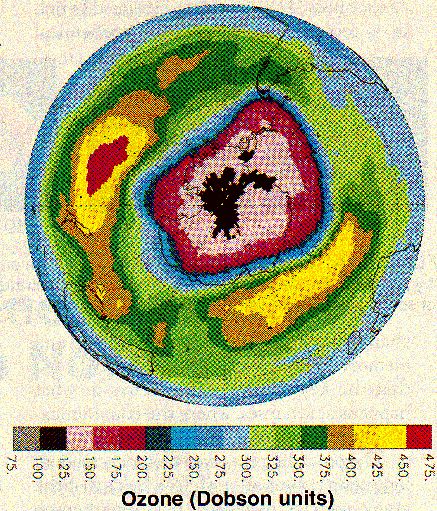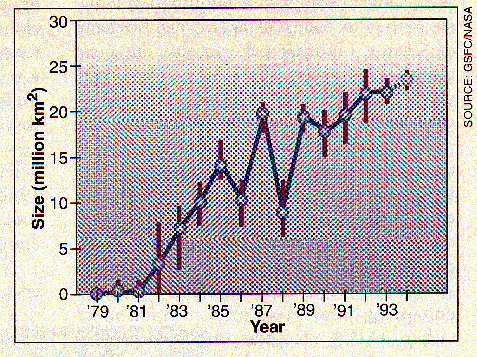
This was supposed to be a better year for ozone over Antarctica. Not a great one, of course, given that the synthetic chemicals that attack the ozone layer each year at this time as the sun hits the Antarctic stratosphere are still there. But researchers expected that last year's record ozone loss wouldn't be repeated. The reason for their optimism was that the volcanic debris spewed by Mount Pinatubo in 1991, which enhanced the chemical destruction of ozone, is nearly gone. But instead of recovering this year, the ozone hole is nearly as deep and wide as ever. For Antarctic ozone, it's been four bad years in a row.

Another bad hole. This year's ozone hole, see by the TOMS instrument in space, nearly matches last year's in depth and size, continuing a 15 year worsening trend (see figure below)

"It's a little bit of puzzle as to why [ozone] values are as low as they are, says Samuel Oltmans of the National Oceanic and Atmospheric Administration in Boulder, Colorado, who monitors ozone above the South Pole using balloon-borne instruments. The most discouraging possibility is that the ozone hole has recovered as much as it can from Pinatubo, but the hole is being deepened and enlarged by the steady increase of chlorine and bromine from synthetic chemicals. Notes Arlin Krueger of the Goddard Space Flight Center (GSFC) in Greenbelt Maryland: "Maybe the hole has returned to normal; 'normal' may be a progressively deepening ozone hole."
That's not what many researchers had expected a few months ago. They assumed that last year's record low of 91 Dobson units (DU) of ozone was largely due to the heavy blanket of debris lofted into the stratosphere by Pinatubo. The microscopic debris par ticles, they knew, provide hospitable sites for the chemical reactions that help destroy ozone. Now that most of the debris has settled out, it seemed, ozone should not drop much lower than 125 DU, the typical annual minimum just before the emption. Although chlorine and bromine levels have increased since then, most researchers thought that their effect might not have grown much, as the regions of the stratosphere where conditions are most favorable to ozone destruction were already suffering almost total loss.
But as of last week, this year's total ozone losses over Antarctica had nearly kept pace with last years. So far, Oltmans has measured ozone levels over the South Pole as low as 102 DU - comparable to 1992's 105 DU and 1991's 108 DU - and they could have dipped lower before the recovery begins this week. All these figures are a far cry from the measurements of the late 1970s, before the hole began to form, when ozone values were about 280 DU at this time of year. The Total Ozone Mapping Spectrometer (TOMS) aboard the Russian Meteor-3 spacecraft, meanwhile, showed that this year's hole covers about 24 million square kilometers, just shy of the 1992 record, according to Paul Newman of GSFC.
Researchers see three factors that, alone or in concert, might explain the continuing near-record severity. One is the temperature 15 to 20 kilometers up in the stratosphere where most of the ozone is lost. The colder it is there, the more effectively chlorine and bromine destroy ozone. This year, the Antarctic stratosphere is a couple of degrees colder than normal, says James Miller of the National Weather Service's Climate Analysis Center in Camp Springs, Maryland. But unusual cold alone probably can't explain the continuing bad news; in 1987, when it was even colder over Antarctica, ozone fell no lower than 121 DU.
In spite of expectations, the Pinatubo debris may also be contrihuting to thc size of the ozone hole. Of the 20 million tons that were originally lofted into the stratosphere, perhaps 3 million still linger, according to Lamont Poole of the Langley Research Cen ter in Hampton, Virginia. And that may be all that's needed for a significant effect on Antarctic ozone, say researchers; the reaction-speeding effect of the aerosol may saturate as its amount increases, and so decreasing the amount wouldn't lead to a proportional improvement in ozone levels.
If unusual cold or lingering volcanic aerosol explains this year's heavy ozone losses, another year could bring some relief. Not so if the increasing amount of chlorine and bromine in the stratosphere is to blame. International controls on chlorofluorocarbons and bromine compounds are expected to halt the increase by 1998 (Science, 23 September, p. 1806), but in recent years stratospheric chlo rine levels have been rising at the rate of a couple of percent per year. That may have been enough to extend ozone destruction beyond the thin layer where major losses were confined before Pinatubo. If those bounds have been breached, it might take several years before researchers monitoring Antarctic ozone finally see bottom.
 Return to Global Change Directory
Return to Global Change Directory